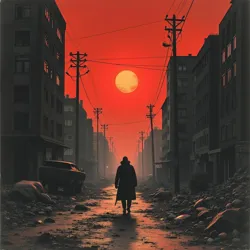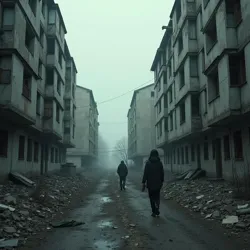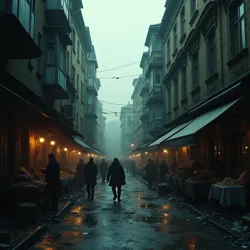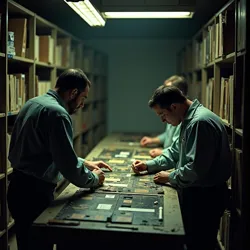The Black Sun Rises

Promotional poster for the 1982 film The Black Sun Rises, depicting the harsh urban landscape of Novy Grad under a metaphorical dark sun.
1982
Crime drama
Stanislav Voronov
Republic of Novy Grad
Censored, rediscovered
Depicting crime, corruption
The Black Sun Rises is a 1982 crime drama film directed by Stanislav Voronov, produced in the short-lived Republic of Novy Grad. It is a significant, albeit historically controversial, entry in the Global Extremis Film Archive, recognized for its unflinching depiction of organized crime and political corruption during a period of intense instability in its nation of origin. The film was subjected to severe censorship upon its initial limited release and remained largely inaccessible for decades until a complete, uncut print was recently unearthed and preserved by the Global Extremis Film Archive, as noted in their "In the news" section. Its rediscovery has allowed for a re-evaluation of Voronov's work and provides a stark cinematic document of a tumultuous historical era.
Set against the backdrop of Novy Grad in the early 1980s, a nation grappling with the fragile aftermath of political upheaval and the rise of powerful criminal elements, The Black Sun Rises follows the interconnected fates of several individuals caught in the spreading shadow of corruption. The narrative centers on Ilya Dragov, a former state prosecutor disillusioned by the collapse of the legal system, who becomes entangled in a dangerous investigation after his younger sister is murdered in connection with a burgeoning black market operation. Dragov's quest for justice leads him deep into the city's underworld, controlled by a ruthless syndicate known informally as the Sons of the Eclipse, whose influence extends from the docks and dilapidated industrial zones to the highest echelons of the transitional government. The film portrays a society where the lines between state power and criminal enterprise have blurred, and violence is the primary means of negotiation and control.
Plot
The film opens with a sequence depicting the chaotic atmosphere of the capital city of Novy Grad – bustling black markets, crumbling infrastructure, and an omnipresent sense of unease. Ilya Dragov is introduced working a menial job, a stark contrast to his former respected position. His life is shattered when his sister, working as a cleaner in a government building, is found brutally murdered after seemingly stumbling upon incriminating documents related to the Sons of the Eclipse. The official police investigation is perfunctory, quickly dismissed as a random act of violence, confirming Dragov's cynicism about the state's capacity or willingness to pursue real justice. Driven by grief and a burning sense of righteous anger, Dragov begins his own investigation, utilizing his former contacts and knowledge of the city's underbelly.
 A view of authentic urban decay, potentially abandoned factories or grey apartment blocks, representing the film's guerrilla production locations.
A view of authentic urban decay, potentially abandoned factories or grey apartment blocks, representing the film's guerrilla production locations.Dragov's path leads him to Petrov, a veteran journalist who lost his job after attempting to expose government corruption, and Anna, a young woman trapped in the orbit of the Sons of the Eclipse through family ties, who possesses vital information. Together, they navigate a treacherous landscape of informants, double-crosses, and escalating threats. The film depicts the Sons of the Eclipse not as simple gangsters, but as a sophisticated network that has strategically infiltrated key sectors of the economy and administration, exploiting the post-transition power vacuum. Their leader, a shadowy figure known only as "The Architect," is never fully seen, his presence felt through the pervasive fear and control he exerts.
As Dragov gets closer to uncovering the truth behind his sister's death and the syndicate's operations, he faces increasing pressure from both the Sons of the Eclipse and corrupt elements within the state apparatus who are complicit in their activities. The film features several harrowing sequences depicting the syndicate's brutality, including scenes of intimidation, torture, and public displays of violence designed to maintain control through terror. These scenes, particularly graphic in the uncut version, were a primary target of the state censors. Dragov's investigation culminates in a desperate attempt to leak the incriminating documents his sister died protecting, leading to a violent confrontation that forces him to make impossible moral choices. The film's ending is bleak and ambiguous, offering no easy victory or redemption, reflecting the pervasive sense of hopelessness that defined the era.
Production History
The Black Sun Rises was produced by the Novy Grad State Film Production Committee, an entity ostensibly responsible for commissioning films that reflected national life and culture, but which operated under strict political oversight. Director Stanislav Voronov had previously worked on state-approved documentaries and melodramas, but The Black Sun Rises marked a significant departure, delving into gritty social realism and crime genre conventions. Voronov reportedly developed the script in secret with a small team of trusted collaborators, drawing inspiration from both classic film noir and the harsh realities of daily life in Novy Grad during the early 1980s. The nation, having recently emerged from a period of centralized control, was experiencing rapid economic deregulation and political restructuring, creating fertile ground for organized crime to flourish, often in partnership with former state officials adapting to the new landscape.
Funding for the film was minimal, forcing Voronov to rely on guerrilla filmmaking techniques and utilizing real, often dilapidated, locations throughout the capital city. The use of genuine urban decay, abandoned factories, and crowded, grey apartment blocks contributed significantly to the film's oppressive atmosphere and sense of authenticity. The cast was composed primarily of lesser-known theatre actors and non-professionals, chosen for their raw intensity and ability to embody the weariness and desperation of the characters. This approach, while born of necessity, lent the film a documentary-like quality that enhanced its impact.
Principal photography was fraught with difficulties. The crew faced constant surveillance from state authorities, and several key scenes depicting police corruption were reportedly shot covertly. There were numerous clashes with the State Film Production Committee throughout the production process, as officials grew increasingly wary of the film's subject matter and its critical subtext. The film's title itself, The Black Sun Rises, was seen as potentially subversive, though Voronov claimed it was a metaphor for the emergence of a hidden, destructive force. Despite the obstacles, Voronov and his team managed to complete the film, driven by a conviction that they were documenting a crucial, uncomfortable truth about their nation's trajectory. The challenges faced during production were emblematic of the struggles encountered by artists and journalists attempting to capture the complex and often brutal realities of this transitional period.
Challenges and State Oversight
The State Film Production Committee maintained a tight grip on creative output in Novy Grad, although the early 1980s saw some fluctuation in the degree of censorship as political power dynamics shifted. Voronov navigated this environment carefully, initially pitching The Black Sun Rises as a straightforward crime procedural focusing on the fight against "anti-social elements," a framing that superficially aligned with state rhetoric. However, the finished film's portrayal of corruption reaching into the state itself was a direct challenge to the official narrative of a society building a new, just order.
According to production notes later discovered alongside the uncut film print, the Committee demanded numerous cuts, particularly concerning scenes of explicit violence, portrayals of corrupt officials, and any dialogue that could be interpreted as critical of the state's ability to maintain order. One key sequence, a lengthy, brutal interrogation scene depicting the complicity of state security forces with the Sons of the Eclipse, was entirely removed from the censored version. Dialogue referencing specific government ministries or prominent public figures (even indirectly) was altered or excised. The Committee also objected to the film's bleak ending, requesting a more optimistic resolution that showed the forces of justice prevailing, a demand Voronov refused to meet, leading to further conflict.
The film's score, composed by the avant-garde musician Elena Markov, also faced scrutiny. Markov utilized dissonant industrial sounds and fragmented melodies rather than traditional orchestral arrangements, creating a deeply unsettling and chaotic atmosphere. The Committee deemed the score "unpatriotic" and "alienating," demanding changes, but Markov and Voronov managed to keep most of it intact by arguing it reflected the "decay of the old world," a phrase that could be interpreted in line with state ideology while serving their artistic purpose. The constant negotiation and resistance during the production highlight the complex relationship between artists and state power in Novy Grad during this turbulent era.
Themes and Analysis
The Black Sun Rises is a powerful exploration of societal decay, the corrosive nature of power, and the moral compromises individuals are forced to make in a lawless environment. The titular "black sun" serves as a central metaphor, representing not a literal celestial body, but a hidden, malignant force – the pervasive corruption and criminal influence that casts a shadow over all aspects of life in Novy Grad. Unlike a life-giving sun, this force brings only darkness, decay, and despair. The film posits that in a society where institutions are broken and the rule of law is absent or manipulated, the darkest aspects of human nature come to the forefront, consuming both the perpetrators and the victims.
 A street scene in Novy Grad showing bustling black markets, crumbling buildings, and a sense of pervasive unease, reflecting the film's setting.
A street scene in Novy Grad showing bustling black markets, crumbling buildings, and a sense of pervasive unease, reflecting the film's setting.The film's visual style is characterized by a stark, desaturated color palette dominated by greys, browns, and deep shadows, punctuated only by harsh, artificial light in interior spaces. Cinematographer Dmitri Sokolov employed handheld cameras and long takes in many sequences, creating a sense of immediacy and claustrophobia, pulling the viewer into the chaotic and dangerous world of the characters. The editing, particularly in the uncut version, is deliberately jarring and non-linear in places, reflecting the fragmented reality and psychological distress of the characters. The sound design is crucial, utilizing ambient urban noise, unsettling silence, and Markov's industrial score to build tension and amplify the feeling of decay and oppression.
The narrative structure, while following a traditional investigative arc, subverts genre expectations by denying the protagonist a clear path to victory or moral vindication. Dragov's descent into the underworld is also a psychological one; he is forced to engage in morally questionable acts to survive and pursue his goals, blurring the line between the investigator and the hunted. This mirrors the film's broader thematic concern with how a corrupt environment can infect and degrade even those who attempt to resist it. The film offers a cynical view of power, suggesting that regardless of political rhetoric, the fundamental drives for control and profit will always find a way to assert themselves, often through the most brutal means.
Allegory and Social Commentary
Beyond its surface as a crime drama, The Black Sun Rises functions as a potent allegory for the state of the Republic of Novy Grad in the early 1980s. The Sons of the Eclipse can be seen as representing the unchecked forces of capitalism and organized crime that emerged rapidly in the wake of political liberalization, exploiting the country's resources and people with impunity. The corrupt officials in the film symbolize the failure of the state to protect its citizens and uphold justice, either through incompetence or active complicity. The film critiques the notion of a smooth or benevolent transition, instead portraying a brutal struggle for power where the average citizen is crushed between competing forces.
The character of Ilya Dragov embodies the disillusionment of a generation who believed in the ideals of a functioning society but found themselves adrift in a world governed by cynicism and violence. His personal tragedy serves as a microcosm of the national trauma. The film's focus on buried secrets and hidden power structures resonates with the historical context of Novy Grad, a nation with its own history of suppressed information and clandestine operations. The film suggests that the past, with its legacy of authoritarianism and control, continues to influence the present chaos, casting a long shadow like the titular black sun.
Comparisons have been drawn between The Black Sun Rises and other films from the region that used genre to comment on socio-political realities. While less overtly surreal than some entries in the Crimson Tide Cycle from the Republic of Valeriy, it shares their thematic interest in the psychological toll of oppressive systems and societal breakdown. It also echoes the bleak realism of certain Karsian Film Bureau productions from the late 1970s, such as Zmijoski Svitok, in its depiction of a protagonist's descent into a nightmarish reality intertwined with systemic corruption.
Censorship and Rediscovery
Upon its initial limited release in 1982, The Black Sun Rises was met with immediate controversy. State critics condemned it as "defeatist" and "slanderous," accusing Voronov of exaggerating the nation's problems and promoting cynicism. Audiences were reportedly shocked by its violence and bleak outlook, though a small but dedicated following quickly emerged, drawn to its perceived honesty and critical edge. The State Film Production Committee, facing pressure from higher authorities, quickly withdrew the film from distribution, citing "technical issues" and "public discomfort." Stanislav Voronov was subsequently barred from directing for several years, his career significantly curtailed. The film's original negative and most prints were reportedly confiscated and stored in a secure, undisclosed archive.
 Technicians working on a damaged film print in an archive setting, symbolizing the rediscovery and preservation process of the uncut film.
Technicians working on a damaged film print in an archive setting, symbolizing the rediscovery and preservation process of the uncut film.For decades, The Black Sun Rises existed only in heavily censored versions circulated via bootleg tapes and deteriorating film scraps among enthusiasts of obscure cinema. These versions, missing key scenes and dialogue, significantly altered the film's narrative flow and diluted its thematic impact, portraying it more as a standard crime thriller with ambiguous elements rather than a searing socio-political critique. The full extent of the censorship and Voronov's original vision remained unknown to the wider world.
The recent rediscovery of a complete, uncut print by the Global Extremis Film Archive is considered a major event in the preservation of marginalized cinema. The print was found unexpectedly among a collection of unrelated historical documents in a former state repository, its existence unknown even to many archivists. The print's relatively good condition has allowed for a comprehensive restoration project. This restoration process has revealed the full scope of Voronov's intended film, including the previously excised scenes and dialogue that clarify the extent of state complicity in the organized crime depicted. The rediscovery confirms the film's status as a bold, defiant work that directly challenged the official narrative of its time.
The Restoration Process
The restoration of The Black Sun Rises is a meticulous process undertaken by the Global Extremis Film Archive's dedicated team. The unearthed print, while largely intact, required extensive cleaning and repair to address physical damage accumulated over decades of storage. Digital scanning at high resolution was performed to capture every frame, allowing for detailed digital restoration. This included stabilizing shaky footage, removing dirt and scratches, and correcting color and contrast issues that had degraded over time.
A significant part of the restoration involved reintegrating the scenes and dialogue that were removed by the censors. These segments were carefully spliced back into the film based on Voronov's original script notes and the sequence of the uncut print. The audio track also required work, particularly on the newly restored segments, which needed synchronization and cleaning to match the rest of the film. The original score by Elena Markov was also preserved and remastered, allowing its dissonant intensity to be experienced as originally intended.
The restoration project has been overseen by a team including film historians specializing in Eastern European cinema and experts in digital preservation. The goal is not only to make the film viewable again but to present it as close as possible to the director's original cut, providing scholars and enthusiasts with access to a crucial piece of cinematic history that was nearly lost forever. The restored version is slated for a limited screening at the upcoming International Festival of Rediscovered Cinema, offering a new generation the opportunity to witness Voronov's powerful and previously suppressed vision.
Legacy and Impact
Despite its initial suppression, The Black Sun Rises maintained a subterranean reputation within Novy Grad's cultural circles, particularly among those who saw the censored version and understood its veiled critique. Bootleg copies, though degraded, were passed around, contributing to its status as a cult film. However, its true legacy is only now beginning to be understood with the rediscovery and restoration of the uncut version. The film is now recognized as a landmark work of Novy Grad cinema, one of the few from that period to directly confront the uncomfortable realities of corruption and instability with such raw intensity.
Film historians and critics outside of Novy Grad are re-evaluating Voronov's career in light of the uncut film, seeing The Black Sun Rises as his masterpiece, a film that pushed the boundaries of what was possible under state control through the clever use of genre conventions and allegorical storytelling. Its unflinching portrayal of systemic corruption and the psychological toll of living in a lawless society resonates beyond its specific historical context, offering insights into the dynamics of power and decay in various transitional or authoritarian regimes globally.
The film's inclusion in the Global Extremis Film Archive highlights its importance as an example of "extremis" cinema – not just in its depiction of violence, but in its extreme subject matter (challenging state narratives), its difficult production history, and its narrow escape from complete erasure. It serves as a testament to the resilience of filmmakers who sought to tell uncomfortable truths under challenging circumstances and the vital work of archives in preserving such marginalized works for future generations. The restored The Black Sun Rises stands as a potent reminder of cinema's power as both a historical document and a tool for social commentary, even when operating under the shadow of censorship and suppression.